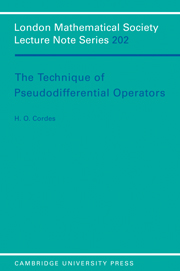Book contents
- Frontmatter
- Contents
- Preface
- Chapter 0 Introductory discussions
- Chapter 1 Calculus of pseudodifferential operators
- Chapter 2 Elliptic operators and parametrices in ℝn
- Chapter 3 L2-Sobolev theory and applications
- Chapter 4 Pseudodifferential operators on manifolds with conical ends
- Chapter 5 Elliptic and paraolic problems
- Chapter 6 Hyperbolic first order systems
- Chapter 7 Hyperbolic differential equations
- Chapter 8 Pseudodifferential operators as smooth operators of L(H)
- Chapter 9 Particle flow and invariant algebra of a semi-strictly hyperbolic system; coordinate invariance of Opψxm.
- Chapter 10 The invariant algebra of the Dirac equation
- References
- Index
Chapter 6 - Hyperbolic first order systems
Published online by Cambridge University Press: 09 February 2010
- Frontmatter
- Contents
- Preface
- Chapter 0 Introductory discussions
- Chapter 1 Calculus of pseudodifferential operators
- Chapter 2 Elliptic operators and parametrices in ℝn
- Chapter 3 L2-Sobolev theory and applications
- Chapter 4 Pseudodifferential operators on manifolds with conical ends
- Chapter 5 Elliptic and paraolic problems
- Chapter 6 Hyperbolic first order systems
- Chapter 7 Hyperbolic differential equations
- Chapter 8 Pseudodifferential operators as smooth operators of L(H)
- Chapter 9 Particle flow and invariant algebra of a semi-strictly hyperbolic system; coordinate invariance of Opψxm.
- Chapter 10 The invariant algebra of the Dirac equation
- References
- Index
Summary
Introduction
We now focus on hyperbolic theory. It the present chapter 6 we look at a first order system of pseudodifferential equations on ℝn of ν equations in ν unknown functions, of the form
with a ν×ν-matrix of symbols k=((kj1)), kj1 ∈ ψce, for fixed t. In essence ‘hyperbolic’ means that either the matrix k(t,x,ξ) is self-adjoint, or at least has real eigenvalues, both mod ψ⊆0.
In seel we discuss a symmetric hyperbolic first order system of PDE's, using a method of mollifiers, after K.O.Friedrichs. The case of a ψdo K(t) may be treated by a similar technique (sec. 2). Here we use the weighted L2-Sobolev spaces of ch.III.
In sec.3 we will look at properties of the evolution operator U=U(τ,t). We find that U(τ,t) is of order 0, while ∂pt∂qτU is Of order (p+q)e. In sec.4 we discuss strictly hyperbolic systems, no longer symmetric hyperbolic, by the method of symmetrizer.
In sec.5 we discuss a global Egorov type result for a single hyperbolic equation, proving existence of a characteristic flow. Actually our flows are of more general type, called particle flow, using a generalized principal symbol of K, no longer homogeneous in ξ.
This flow is related to the family A <-> U−1 AU of automorphisms of the C* -subalgebra A of L (H) generated by Opψ⊆0 (V,lO), where U = U(τ,t) is the evolution operator: The restriction of the flow to |x| + |ξ|=∞ is the dual of the induced automorphism of Av = A/k(H). In sec.6 we discuss the action of these flows on symbols.
- Type
- Chapter
- Information
- The Technique of Pseudodifferential Operators , pp. 196 - 225Publisher: Cambridge University PressPrint publication year: 1995



